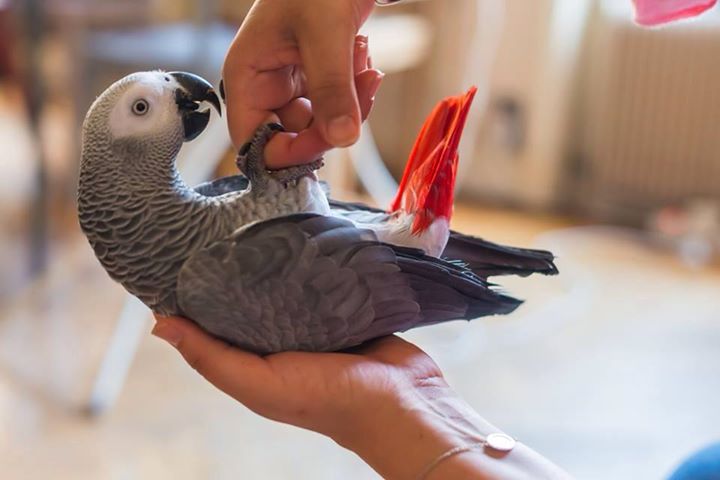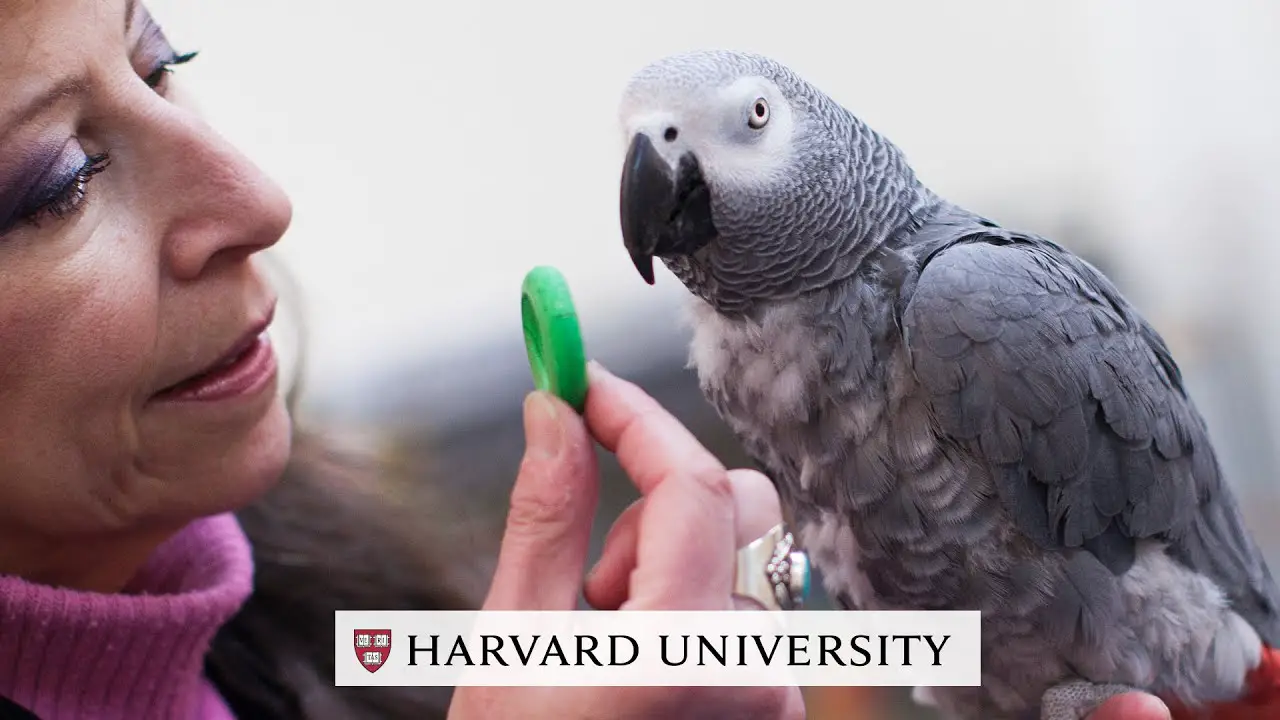Avian Articles, Blogs
Alex the Parrot’s Final Words: A Heartfelt Goodbye
Imagine having a pet that not only understands you but can also speak your language. This was the amazing bond between Irene Pepperberg and her African grey parrot, Alex. For over three decades, Pepperberg’s research showed how smart and talkative this parrot was.
Alex’s last words before he passed away at 31 were very touching. He said, “You be good. I love you. See you tomorrow.” These words, spoken in perfect English, moved everyone who knew Alex.
Alex was known for his amazing brain power. He knew over 100 English words and could count up to six objects with 80% accuracy. His math skills were better than many animals, showing how smart parrots can be.
What made Alex stand out was how different he was from others. Griffin, another parrot, learned only 20 words in 12 years. This showed how unique each parrot can be, making Alex’s skills even more remarkable.
Alex’s brain was as sharp as a five-year-old child’s. His feelings were like a two-year-old’s. This mix of smarts and feelings showed that birds like Alex are much more complex than we thought.
Thanks to Irene Pepperberg’s work with Alex, our view of bird intelligence changed. Alex’s story amazed and inspired many, proving that parrots are smarter than we thought.
Key Takeaways:
- Alex, the African grey parrot, had a confirmed vocabulary of over 100 English words.
- Alex could correctly count up to six objects with 80% accuracy, showcasing his numerical abilities.
- Griffin, another parrot in the study, had mastered only 20 words after 12 years, highlighting the variance in language abilities among different parrots.
- Alex’s intelligence was compared to that of a five-year-old child, while his emotional behavior was likened to that of a two-year-old.
- The impact of three decades of parrot research, including the study of Alex, led to a shift in how people perceive the intellectual abilities of birds.
Alex’s Contributions to Animal Intelligence Research
Alex, an African gray parrot, changed the way we see animal intelligence. His experiments showed off his amazing thinking and language skills. He proved that animals are smarter and can talk better than we thought.
Alex lived for 31 years, much longer than parrots usually do. He amazed researchers with how fast he learned. He learned over 100 words and could spot at least 50 different objects. He could tell apart colors, shapes, materials, and numbers, showing he was very smart.
Researchers tested Alex with objects of different colors and shapes. He was very good at picking them out and sorting them. He could count up to six, proving he had a strong mind2.
Alex was special because he learned to talk and use language in new ways. He asked questions, a first for a non-human, which was a big deal in animal research2. He went from making sounds to saying whole words, showing he understood language well. He also got abstract ideas like “bigger” and “different,” showing he could think deeply.
Alex also showed he could make smart choices. He could use words like “none” to talk about objects, showing he thought things through. Dr. Irene Pepperberg taught him using a special method that worked well, showing how smart Alex was.
Dr. Pepperberg still studies other parrots like Athena and Griffin, building on Alex’s work. These parrots are learning new things, helping us understand animals better. Alex’s work changed how we see animal intelligence, showing us how smart animals can be.
Alex’s Contributions to Animal Intelligence Research
Alex’s Language and Cognitive Abilities
Alex, the African Grey parrot, amazed the world with his language and thinking skills. His work showed how smart and communicative birds can be, changing what we thought about animal smarts.
Dr. Irene Pepperberg studied Alex and found he learned over 100 English words. This made him a key figure in studying how animals talk.
Dr. Pepperberg’s new teaching methods helped Alex learn. He watched trainers and learned to talk back using a special way of communicating. This new method showed us birds are smarter than we thought.
Alex knew about 150 words, which was a lot for a bird at the time. He could count, sort words, colors, and shapes. This showed he was very smart, unlike most birds.
Alex lived for 31 years, which was a long time for a smart bird like him. His life helped us understand how long birds like him can live and think.
Alex was smart in many ways, not just talking. He knew things like objects stay even when out of sight, and he understood simple math and colors. He could also show surprise or get mad when things didn’t go as expected.
Comparing him to other animals, Diana Reiss said Alex changed how we see bird smarts. His skills showed us birds are more complex than we thought.
But, some scientists said Alex’s talking skills were still different from humans. They pointed out he didn’t reason or generalize like humans do. This shows we need to understand animal communication better.
Summary of Alex’s Language and Cognitive Abilities
| Language and Cognitive Abilities | Statistical Findings |
|---|---|
| Number of English words learned by Alex | Over 100 words |
| Vocabulary size | Around 150 words |
| Bird species studied at the time | Alex’s advanced language skills compared to other bird species |
| Alex’s lifespan | 31 years |
| Cognitive abilities demonstrated | Counting, categorization, shape and color recognition, understanding concepts like “bigger” and “smaller” |
Alex’s Unique Language Skills
Alex the African grey parrot was special because he could use language in a unique way. He could mimic human speech and understand words and concepts on a high level. This showed advanced communication between animals and humans. His skills came from a thirty-year experiment by Irene Pepperberg.
Alex amazed researchers with his language skills throughout his life. He was born on May 18, 1976, in the UK and lived until he was 31 at Brandeis University in Massachusetts, USA. He knew over 100 words, showing he understood and comprehended a lot.
Alex could describe objects by their shape, color, and material. He even asked deep questions, making him the first animal to do so. He showed he could communicate his needs and preferences. This showed he understood human communication well.
Alex’s skills went beyond just naming objects and asking simple questions. He understood concepts like “bigger” and “smaller.” He could learn new words and even do math tasks better than some humans.
In tests, Alex showed he understood and communicated well. He got the right answer about 80 percent of the time, showing his smart thinking. His mind was as sharp as a five-year-old human’s, and his feelings were like a two-year-old’s.
Alex also understood language structure and the concept of zero. He even saw optical illusions like humans do.
Alex was learning to recognize English words, linking written and spoken language. This showed he could communicate in English, making human and animal communication closer.
Alex died at 31, cutting short his amazing journey. Grey parrots usually live 45 years in captivity, so his death was too soon. His last words to Irene Pepperberg were touching: “You be good. I love you. See you tomorrow.”
Even though Alex’s skills were celebrated, some experts questioned them. They wondered if his language was from training or true understanding.
Summary Table: Alex’s Unique Language Skills
| Vocabulary | Ability to Describe Objects | Asking Questions | Understanding of Quantities and Concepts | Cognitive Skills |
|---|---|---|---|---|
| Over 100 words | Identify objects by shape, color, and material | Pose existential questions | Recognize quantities up to six, distinguish seven colors and five shapes | Exceptional comprehension, advanced cognitive abilities, and perception of optical illusions |
Alex’s Legacy and Impact
Alex the African grey parrot changed how we see animal intelligence. Irene Pepperberg’s work with Alex showed us how smart animals can be. Alex proved that birds and other animals are more than just simple creatures.
Many thought parrots just mimicked sounds without understanding them. But Alex showed he could count up to six items and think abstractly. He could identify colors, shapes, and materials too.
Alex was a master of language, using over 100 words to talk about objects and more. He even added numbers in Roman numerals up to eight and put them in order. These skills showed his deep thinking.
Alex changed how we see animal intelligence and formed a strong bond with Irene Pepperberg. Their story is in “Alex & Me” by Irene M. Pepperberg. This book shows the deep connection between humans and animals.
Alex died at 31, leaving a big mark. African greys can live up to 60 years, so his death was sudden and unexpected. Yet, his work still inspires us to learn more about animal intelligence.
Conclusion
Alex the Parrot made a big impact on how we see animal smarts. He knew up to 150 words and could spot about 50 different things. He could count, see seven colors, and shape five, and use words in the right way. His work with Dr. Pepperberg for 30 years changed what we thought birds could do.
Even when it was hard to get support, Dr. Pepperberg kept going with Alex. She taught him words like “paper,” “key,” and “wood”. He learned to connect words with things, showing he got what he wanted. Alex was fun and smart, understanding complex ideas like sounds and “none”.
Alex’s last words, “You be good. I love you. You’ll be in tomorrow”, were very touching. They show how much he understood and felt for people. His work inspires us to learn more about parrots and animals in general. Dr. Pepperberg keeps studying with parrots like Griffin and Athena, helping us understand birds better. Alex will always be a hero in the field, showing us how smart animals can be.


